View in other NatureServe Network Field Guides
NatureServe
Montana
Utah
Wyoming
Idaho
Wisconsin
British Columbia
South Carolina
Yukon
California
New York
Pronotal Range Grasshopper - Cratypedes neglectus
General Description
The following is taken from Hebard (1928), Brooks (1958), Helfer (1971), Otte (1981), Capinera and Sechrist (1982), Vickery and Kevan (1985), McDaniel (1987), Capinera et al. (2004), and Scott (2010). This is a medium to large, robust grasshopper with a grayish-brown body color, and is normally marked with pale stripes on the forewings (tegmina) which form a V-shape when folded. The wings extend beyond the abdominal tip and are spotted, which often coalesce into distinct dark bands. The hind wing disk is yellow, boarded by a broad black crossband with the anterior spur almost reaching the base. The outer tip is clear. The outer face of the hind femur is dark and usually banded. The femur inner face bears two complete or incomplete dark bands, the background color can vary from ivory, orange, or red. The hind tibia is reddish or orange, sometimes yellow.
Communicative behavior/crepitation*:
Flights are generally straight and range in distance from about 9-30 feet. During flight, crepitation can be heard as a loud crackling sound. No studies in the literature can be found relative to male stridulation and other courtship communicative behavior (Vickery and Kevan 1985).
*Crepitation is the sound produced by grasshoppers making a clicking or snapping noise with their wings when in flight, during courtship, territorial encounters or being disturbed.
Phenology
The Pronotal Range Grasshopper overwinters in the egg stage. Nymphs hatch from early May to mid-June. Adults occur from June through August, depending upon altitude (Otte 1981, Vickery and Kevan 1985, Capinera et al. 2004, and Scott 2010).
Diagnostic Characteristics
The following comes from Hebard (1928), Brooks (1958), Helfer (1971), Otte (1981), Capinera and Sechrist (1982), Vickery and Kevan (1985), McDaniel (1987), Capinera et al. (2004), and Scott (2010). Body length for males is 24-32 mm, and for females 33-40 mm. The lateral lobes of the pronotum (thorax) is wider ventrally than in the middle. The pronotum is rough or bumpy and the median carina (ridge) is cut by 2 sulci (grooves).
This species can be confused with
Red-shanked Grasshopper (
Xanthippus corallipes), and both
Pardalophora species, the
Coral-winged Grasshopper (
P. apiculata) and the
Haldeman’s Grasshopper (
P. heldemanii) (Vickery and Kevan 1985).
Species Range
Montana Range
Range Descriptions
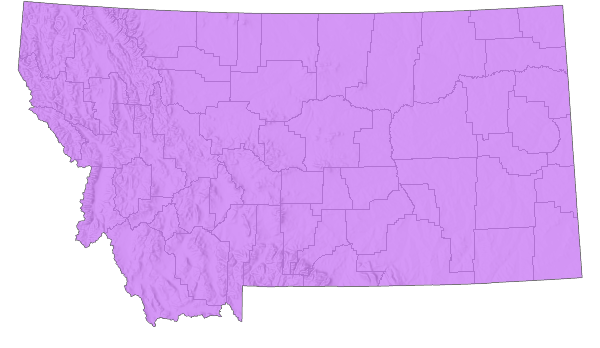
 Native
Native
Range Comments
The Pronotal Range Grasshopper is distributed widely in western North America, occurring from the north across southern British Columbia to southwest Manitoba, southward to northern Arizona and north-central New Mexico. From west to east, mountain areas of California to central Colorado, through Wyoming and the western third of Montana, with a few extended reports from the Nebraska panhandle and eastern North Dakota. In Montana, it has been reported for 20 counties, mostly concentrated from the western to the central region of the state (Otte 1981, Vickery and Kevan 1985, and Scott 2010).
Observations in Montana Natural Heritage Program Database
Number of Observations: 21
(Click on the following maps and charts to see full sized version)
Map Help and Descriptions
Relative Density
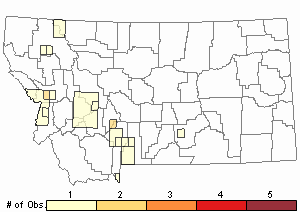
Recency
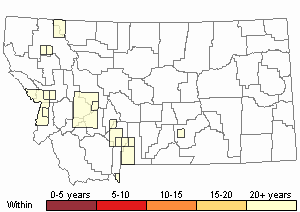
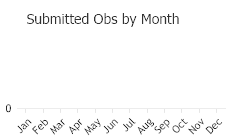
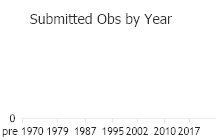 (Observations spanning multiple months or years are excluded from time charts)
(Observations spanning multiple months or years are excluded from time charts)
Habitat
Inhabits a diversity of habitats but favors open sunny areas in open pine woodlands, brushy areas, sagebrush steppe, and mixed-grass prairies with dry, sandy soils (Brooks 1958, Otte 1981, Vickery and Kevan 1985, and Capinera et al. 2004).
Food Habits
This species primarily consumes grasses (Brooks 1958, Otte 1981, Vickery and Kevan 1985, Capinera et al. 2004).
Reproductive Characteristics
Detailed courtship and reproduction is unknown, except that nymphs pass through 5 instars to the adult stage (Capinera and Sechrist 1982).
Stewardship Responsibility
References
- Literature Cited AboveLegend:
 View Online Publication
View Online Publication Brooks, A.R. 1958. Acridoidea of Southern Alberta, Saskatchewan, and Manitoba (Orthoptera). The Canadian Entomologist (Supplement 9) 90:5-92.
Brooks, A.R. 1958. Acridoidea of Southern Alberta, Saskatchewan, and Manitoba (Orthoptera). The Canadian Entomologist (Supplement 9) 90:5-92. Capinera, J.L. and T.S. Sechrist. 1982. Grasshoppers of Colorado: Identification, Biology, and Management. Fort Collins, CO: Colorado State University Experiment Station, Bulletin 584S. 161 p.
Capinera, J.L. and T.S. Sechrist. 1982. Grasshoppers of Colorado: Identification, Biology, and Management. Fort Collins, CO: Colorado State University Experiment Station, Bulletin 584S. 161 p. Capinera, J.L., R.D. Scott, and T.J. Walker. 2004. Field Guide to Grasshoppers, Katydids, and Crickets of the United States. Ithaca, NY. Cornell University Press.
Capinera, J.L., R.D. Scott, and T.J. Walker. 2004. Field Guide to Grasshoppers, Katydids, and Crickets of the United States. Ithaca, NY. Cornell University Press. Hebard, M. 1928. The Orthoptera of Montana. Proceedings of the Academy of Natural Sciences of Philadelphia, Vol. 80:211-306.
Hebard, M. 1928. The Orthoptera of Montana. Proceedings of the Academy of Natural Sciences of Philadelphia, Vol. 80:211-306. Helfer, J.R. 1971. How to Know the Grasshoppers, Crickets, Cockroaches, and Their Allies. Revised edition (out of print), Mineola, NY: Dover Publications.
Helfer, J.R. 1971. How to Know the Grasshoppers, Crickets, Cockroaches, and Their Allies. Revised edition (out of print), Mineola, NY: Dover Publications. McDaniel, B. 1987. Grasshoppers of South Dakota. Brookings, SD: South Dakota Agricultural Experiment Station, Bulletin TB 89.
McDaniel, B. 1987. Grasshoppers of South Dakota. Brookings, SD: South Dakota Agricultural Experiment Station, Bulletin TB 89. Scott, R.D. 2010. Montana Grasshoppers, Katydids, and Crickets A Pictorial Field Guide to the Orthoptera. MagpieMTGraphics, Billings, MT.
Scott, R.D. 2010. Montana Grasshoppers, Katydids, and Crickets A Pictorial Field Guide to the Orthoptera. MagpieMTGraphics, Billings, MT. Vickery, V. R. and D. K. M. Kevan. 1985. The grasshopper, crickets, and related insects of Canada and adjacent regions. Biosystematics Research Institute, Ottawa, Ontario. Publication Number 1777. 918 pp.
Vickery, V. R. and D. K. M. Kevan. 1985. The grasshopper, crickets, and related insects of Canada and adjacent regions. Biosystematics Research Institute, Ottawa, Ontario. Publication Number 1777. 918 pp.
- Additional ReferencesLegend:
 View Online Publication
View Online Publication
Do you know of a citation we're missing? Anderson, N.L. 1962. Grasshopper-vegetation relationships on Montana grasslands. Ph.D Dissertation. Bozeman, Montana: Montana State University. 73 p.
Anderson, N.L. 1962. Grasshopper-vegetation relationships on Montana grasslands. Ph.D Dissertation. Bozeman, Montana: Montana State University. 73 p. Brust, M.L, W.W. Hoback, and R.J. Wright. 2008. The Grasshoppers of Nebraska. Lincoln, NB: University of Nebraska Extension Service, APHIS.
Brust, M.L, W.W. Hoback, and R.J. Wright. 2008. The Grasshoppers of Nebraska. Lincoln, NB: University of Nebraska Extension Service, APHIS. Otte, Daniel. 1981. The North American Grasshoppers. Volume 1. Acrididae (Gomphocerinae and Acridinae). Harvard University Press. 275 pp.
Otte, Daniel. 1981. The North American Grasshoppers. Volume 1. Acrididae (Gomphocerinae and Acridinae). Harvard University Press. 275 pp. Otte, Daniel. 1984. The North American Grasshoppers Volume II. Acrididae (Oedipodinae). Harvard University Press. 366 pp.
Otte, Daniel. 1984. The North American Grasshoppers Volume II. Acrididae (Oedipodinae). Harvard University Press. 366 pp. Skinner, K.F. 1995. Plant and grasshopper community composition: indicators & interactions across three spatial scales. M.Sc. Thesis. Bozeman, MT: Montana State University. 144 p.
Skinner, K.F. 1995. Plant and grasshopper community composition: indicators & interactions across three spatial scales. M.Sc. Thesis. Bozeman, MT: Montana State University. 144 p.
- Web Search Engines for Articles on "Pronotal Range Grasshopper"
- Additional Sources of Information Related to "Insects"





